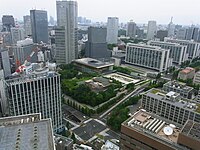Prime Minister's Official Residence (Japan)
| Prime Minister's Official Residence | |
|---|---|
総理大臣官邸 | |
 | |
 The Kantei from the valley side | |
 Prime Minister's Official Residence | |
| General information | |
| Address | 2-3-1 Nagatachō Chiyoda-ku 100-8968 |
| Town or city | Tokyo |
| Country | Japan |
| Coordinates | 35°40′23″N 139°44′35″E / 35.673°N 139.743°ECoordinates: 35°40′23″N 139°44′35″E / 35.673°N 139.743°E |
| Current tenants | Prime Minister of Japan, Spouse of the Prime Minister and Family, Cabinet Secretariat |
| Construction started | May 22, 1999 |
| Completed | April 22, 2002 |
| Height | 35 meters |
| Technical details | |
| Floor count | 5 floors above ground, 1 basement |
| Floor area | 25,000 m² |
| Grounds | 46,000 m² |
| Design and construction | |
| Architect | Ministry of Land, Infrastructure, Transport and Tourism, Minister's Secretariat |
| Website | |
| kantei.go.jp | |
The Prime Minister's Official Residence is the official workplace and residence of the Prime Minister of Japan. It is commonly referred to as Sōri Daijin Kantei (総理大臣官邸),[1] Shushō Kantei (首相官邸), or simply Kantei (官邸).
About[]



Located at 2-3-1 Nagata-chō, Chiyoda-ku, Tokyo 100–8968, it is diagonally adjacent to the National Diet Building. The new residence went into service in April 2002[2] and replaced the former residence, built in 1929. The former residence is now known as the Sōri Kōtei (総理公邸), the official Prime Minister's Residential Quarters. The term Kantei is used as a metonym for the office of the Prime Minister of Japan and for the Prime Minister's advisors and administration in general.
In addition to the Prime Minister's Official Residence being the principal office of the Prime Minister, the Chief Cabinet Secretary and the Deputy Cabinet Secretaries perform their daily duties, it is also the place where important Cabinet meetings take place, where foreign leaders are welcomed and entertained, and is also the location of a national crisis management center.[3]
Name[]
The Prime Minister's Official Residence is called Sōri Daijin Kantei (総理大臣官邸), also known as the Sōri Kantei (総理官邸), the Shushō Kantei (首相官邸) or simply the Kantei (官邸). The Residential Quarters is called Sōri Kōtei (総理公邸).
History[]
With the evolution of a national parliament after the Meiji Restoration and the establishment of the post of "Prime Minister of Japan" in 1885, the need for an official prime ministerial residence was felt. On the encouragement of Prime Minister Tanaka Giichi, the first residence was completed on 18 March 1929. It was a two-storied mansion designed by , of the Ministry of the Treasury (now Ministry of Finance)[4] and was heavily influenced by the architecture of Frank Lloyd Wright. Indeed, Prime Minister Tanaka is said to have exclaimed, "This is just like a café, isn't it?",[5] upon seeing the Art Deco style of the building.
By the 1990s, the 5,200 square metres (56,000 sq ft) building was deemed cramped and insufficient, and a new five-storied residence was built in 2002 next to the old, with 2.5 times the floor space.[6] Installed with solar panels and a rainwater storage system, the new building has been designed to minimize environmental impact.[7]
In an April 2015 incident, a Phantom 2 drone carrying traces of radiation was found on the roof of the PM's office.[8] It had been controlled by Yasuo Yamamoto, an anti-nuclear protester from Fukui Prefecture.[9] Yamamoto flew the drone there carrying sand containing cesium from Fukushima prefecture on April 9, but the drone was not discovered until April 22.[10] Yamamoto later received a two-year suspended sentence.[11]
Former official residence (1929)[]

The old official residence was completed on March 18, 1929. It incorporates architectural styles such as art deco and expressionist architecture which became popular from the late Taishō period to the early Shōwa period. It has similarities to Frank Lloyd Wright's design of the former second Imperial Hotel main building. It was designed by the Ministry of Finance, Ministry of Construction and Shimomoto Muraji.
The building of the former official residence was renovated and it is now being used as the Prime Minister's official Residential Quarters (Sōri Kōtei).
Outline of the former official residence:
- Completed on March 18, 1929 (Showa 4)
- Reinforced concrete 4 stories (3 floors above ground and 1 basement)
- Total floor area: 7000 square meters
- Design: Ministry of Finance, Ministry of Internal Affairs and Administration (in charge: Mr. Shimomoto Muraji)
Notes[]
- ^ 部局課名・官職名英訳名称一覧 Names of Government Organizations and Positions, June 9, 2008.
- ^ "Overview of the Prime Minister's Official Residence". Cabinet Secretariat of Japan. Retrieved 2009-05-29.
- ^ "Support staff at Kantei". Cabinet Secretariat of Japan. Retrieved 2009-05-29.
- ^ "An Overview of the Prime Minister's Official Residence". Cabinet Secretariat of Japan. Retrieved 2009-05-29.
- ^ "The Entrance Hall". Cabinet Secretariat of Japan. Retrieved 2009-05-29.
- ^ "An Overview of the Prime Minister's Official Residence". Cabinet Secretariat of Japan. Retrieved 2009-05-29.
- ^ "Environmental measures and barrier-free environment". Cabinet Secretariat of Japan. Retrieved 2009-05-29.
- ^ Drone 'containing radiation' lands on roof of Japanese PM's office April 22, 2015 The Guardian Retrieved May 4, 2015
- ^ Japanese police say man arrested after he admits landing drone at prime minister's office April 25, 2015 U.S. News & World Report Retrieved May 4, 2015
- ^ Man lands drone carrying radioactive sand on Japanese prime minister’s office April 26, 2015 Ars Technica Retrieved May 4, 2015
- ^ Murai, Shusuke Man who landed drone on roof of Japanese prime minister’s office gets suspended sentence February 16, 2016 Japan Times Retrieved February 29, 2016
External links[]
| Wikimedia Commons has media related to Prime Minister's Official Residence (Japan). |
- Official residences in Japan
- Buildings and structures in Chiyoda, Tokyo
- Prime ministerial residences
- Government buildings completed in 1929
- Houses completed in 1929
- Government buildings completed in 2002
- Houses completed in 2002
- 2002 establishments in Japan
